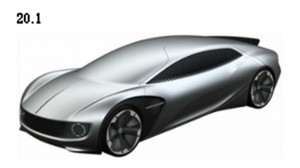
Patent images of VW's ID reveal just the start of what the maker promises to be an onslaught of 30 EVs.
When Volkswagen unveiled its ID battery-electric concept vehicle at the Paris Motor Show last month, company officials promised it would usher in a dramatic shift in the automaker’s future product plans.
Set to reach market no later than 2020, the VW ID will be the first of 30 battery-electric vehicles from the German maker as it shifts from its familiar, albeit tarnished, diesel line-up to a focus on zero-emission powertrain technologies.
The ID concept adopts the skateboard-like platform already used by Tesla and that will be adopted by other makers, including General Motors and Faraday Future. The layout provides the opportunity to radically change the basic shape of tomorrow’s vehicles – especially if they also adopt autonomous and even driverless technologies. And some patent images attributed to VW suggest some of the things the maker might have in development.
These images, uncovered by both Britain’s Autocar, as well as various members of the VWVortex forum, show that Volkswagen is apparently looking to cover the gamut: everything from sporty coupes to jitney-style people-movers.
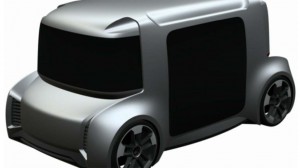
Volkswagen is apparently looking to cover the gamut: everything from sporty coupes to jitney-style people-movers.
That’s no surprise considering the fact that many experts foresee a dramatic transformation coming in the transportation industry. With the growth of global megacities ad the emergence of car- and ride-sharing companies like Uber, Lyft and Car2Go, many motorists may give up their personal automobiles in favor of these alternatives.
(VW wants to cut 25,000 jobs in Europe during next decade. Click Here for the story.)
At least one of these designs suggests VW might do away with the windshield, though it’s more likely the conventional glass would be replaced by a screen that could sub as a video or augmented reality display, depending upon whether a motorist were actually driving or simply laying back to enjoy the ride.
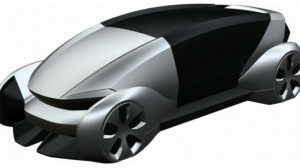
The various VW images that have leaked out includes at least one relatively conventional design, though it does seem to hint at an active fin.
At least some of these concepts seem directly aimed at ride-sharing applications. There’s expected to be a good market for that, especially if and when driverless technology proves viable. A pilot program is already underway on a series of routes in Singapore. And Ford Motor Co. says it intends to have its first fully driverless vehicle in production by 2020.
The various VW images that have leaked out includes at least one relatively conventional design, though it does seem to hint at an active fin that could be deployed to improve aerodynamics at higher speeds.
There already are a number of vehicles with active wings, and the BMW Vision Next 100 concept revealed earlier this year goes so far as to use flexible body panels that would reduce drag around the front wheels, so we’re expecting more active aero technology to appear in the years ahead.
(Click Here for details about VW’s new direction, starting with the ID.)
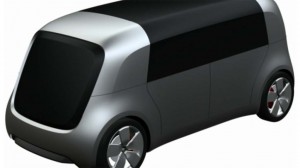
All the various concepts appear to have in common is a flexible architecture that Volkswagen has dubbed the Modular Electric Drive Kit, or MEB.
What all the various concepts appear to have in common is a flexible architecture that Volkswagen has dubbed the Modular Electric Drive Kit, or MEB in German shorthand.
It’s conceptually similar to the platform used for the Tesla Models S and X. Think of it as a skateboard, with the battery pack mounted below the floorboards. That approach lowers the center of gravity, a critical issue in a vehicle that might carry 700 pounds or more of lithium-ion cells.
And it frees up space traditional taken up by a gas or diesel powertrain. So, a vehicle with a compact footprint might offer the interior space of a full-size model. That would be particularly useful for a van or people-mover design.
The VW ID concept car introduced in Paris featured a 168 horsepower electric motor drawing energy from a 125 kilowatt-hour battery pack capable of delivering somewhere between 250 and 375 miles per charge. That would make it much more compatible with the conventional vehicles of today – and, for car- and ride-sharing purposes, allow a vehicle to remain in use all day without the need to pull it off-line for charging.
(Check out our first drive in the 2017 VW Alltrack. Click Here for the story.)
Whether any of these images will actually make it into production is far from certain, but they suggest that VW – and its competitors – will be looking at a variety of unconventional options in the future.

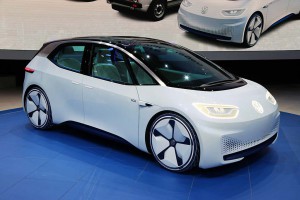
VW – Boy Cried Wolfsburg all over again..and again and again.
Enough with the endless Zukunftsmusik already !
VW, BMW – the German auto establishment – perpetual procrastination, endless jam tomorrow promises: the reality and truth is exposed not least by what Renault(Zoe range doubled), GM(Bolt) and obviously Tesla are doing in the >present tense< and in the real world.
VW and BMW have the technology to – for instance – increase the range of the e-Golf and i3 NOW, yesterday, last year..they get away with the perpetual procrastination primarily because they are subjected to near-zero pressure from our appallingly compliant media and of course from equally compromised governments.
Paul G Electric Vehicles UK
http://www.EVUK.co.uk